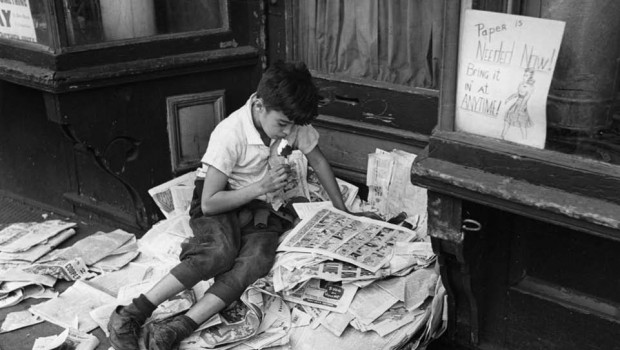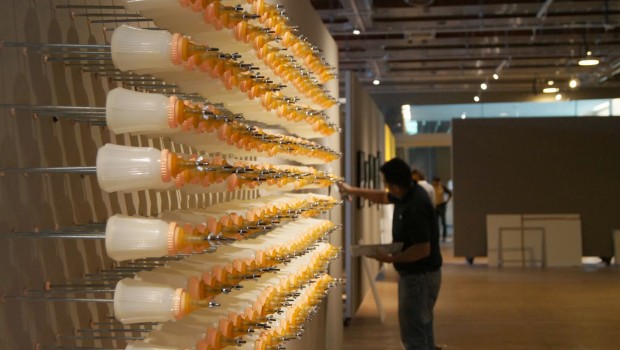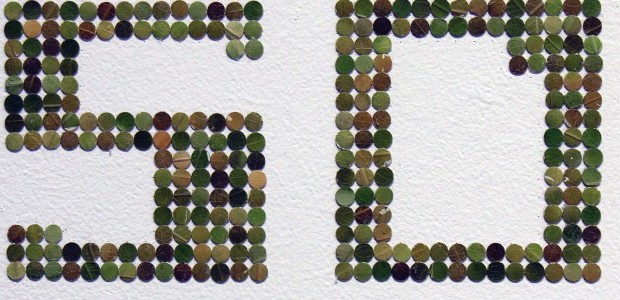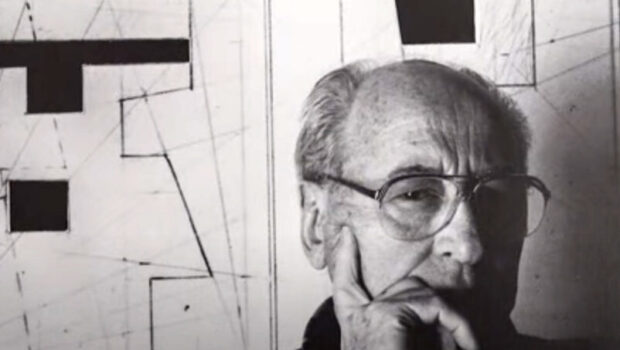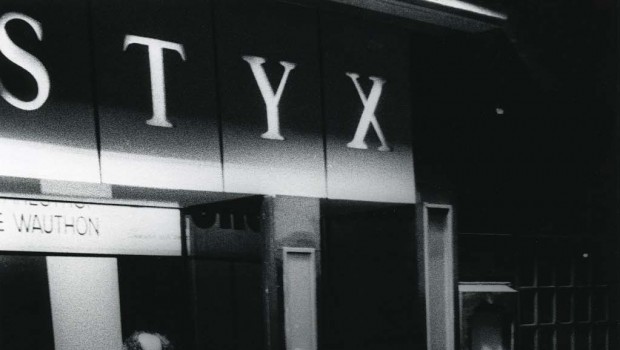André Kertesz: On Reading
Sven Birkerts
On Reading: “The Mystery of the Representation”
The Open Book is an Open Door
It was my friend the poet Fred Marchant who a few years back sent me a small book of photographs by Andre Kertesz called simply On Reading. I didn’t sit down to look at it right away, I remember, but instead I performed that childhood ritual of deferral, saving it up so that I could have two pleasures–the anticipation and the looking. I had been a fan of Kertesz’s work for many years–indeed a book of his photographs of Paris had been a kind of dreaming machine for me back when I was still embellishing my fantasies of the writing life with romantic visuals. I would page through my Kertesz boo–it was called J’aime Paris–again and again, feeling that the only thing missing in these images was me. And now here he was again, Kertesz, tantalizing me with another kind of mirage: people captured in moments of the most private kind of free-fall.
Not free-fall through the outer atmosphere–which for me is the emblem for the ultimate freedom–but through the inner scape, which is not a bad default.
Images of people reading–a whole suite of them, offering up a very particular view of this thoroughly mysterious and compelling activity.
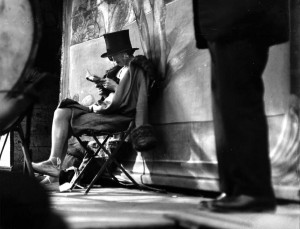 Right at the threshold we face the paradox, that photography is an art committed to outer surfaces, while reading, silent reading anyway, is an act that unfolds in pure inwardness. Not only does it unfold in inwardness, it unfolds it, creates content in the figurative space that thought makes possible. The inner holds the outer. I can far more readily imagine reading a text that clarifies photography than I imagine looking at a photograph that clarifies reading. It does, however, propose a whole field of suggestion, creating, in effect, a vast screen for our projections. I will come back to this.
Right at the threshold we face the paradox, that photography is an art committed to outer surfaces, while reading, silent reading anyway, is an act that unfolds in pure inwardness. Not only does it unfold in inwardness, it unfolds it, creates content in the figurative space that thought makes possible. The inner holds the outer. I can far more readily imagine reading a text that clarifies photography than I imagine looking at a photograph that clarifies reading. It does, however, propose a whole field of suggestion, creating, in effect, a vast screen for our projections. I will come back to this.
But first, two other striking paradoxes that we encounter in these images, both of which likewise go right to the heart of the question ‘what is reading?’ First, just as there is a complete opposition between the outwardness of image and the inwardness of text, there is also a polarity between the necessary stillness of the captured subject–the reading act is characterized by its essential immobility (to-and-fro of the eyes, periodic exertion of the fingers to turn the page)–and its distinguishing unseen property, which is the most concentrated dynamism. Whether the reader is engaged in a strenuous plot action or a synopsis of Byzantine lawmaking, the mind’s action is focused and consuming and is in no way represented by the person’s outward aspect. Nothing so vividly depicts the split between the bodily and the mental as the image of the engaged reader.
The other paradox has to do with perspective–that of the reader versus that of the observer. For the longest time I was haunted by the sense that there was something ‘off’ in these representations of the reader captured in whatever setting, utterly immersed in the book he or she is holding. Then I got it. I realized that, given the basic nature of the act, the engaged reader is never aware of a setting; only the person beholding the image is. This is not true for the solitary eater, drinker, daydreamer–all are to some degree attuned to their surroundings. But to the degree that the reader is reading, that awareness has vanished. In this way too does the ‘objective’ presentation of the image misrepresent that which it is framing.
But wait. Misrepresentation–this sounds like a harsh verdict to hand down to art. Moreover, it misleads as to the power and suggestiveness of what Kertesz has achieved in these photographs. I would say, rather, that as an artist clearly attuned to the power of the act, he creates his images through an awareness of these same core paradoxes. He understands that they are what make the mystery of the representation.
I don’t know if the arrangement of photographs in the book was done by Kertesz or his editors. Was it his decision to feature on the cover the shot of an old white-haired woman sitting upright in her bed, its curtains parted, and what looks to be a silver teapot on the small table in the foreground? The woman’s head–she has some kind of black headgear, perhaps a shawl covering part of her hair–is centered, framed and also backed by the complex white folds of the curtain coming down from the top of the grand bed, folds which look like nothing so much as pages of a book viewed from the side. Was this also Kertesz’s thought? The point of this photo–as of every photo in the book, finally–is to capture the intensity and absorption of a person with a book. This comes across to the viewer as absolute. The subject is viewed in profile. The woman holds the book at a 45-degree angle not two feet from her face. The whole transaction, the field of action, is in the interval, which feels absolutely charged. Of course this is my imagining. Light-sensitive film cannot capture human concentration, only the gestures and expressions appropriate to it. Nor do we have any idea what the old woman is reading–it could be the most trivial chatter ever bound between covers, or the Gospels. Maybe it doesn’t matter for the meaning of the photo, the only important thing being the sensation that everything, the travails of great old age included, has been for the moment transcended, displaced by the mind’s immersion in symbols.
What feels to me like the true inaugural photograph–facing the copyright page–is one of only two in the book without a human subject. There is just an open volume on a table beside a curtained window. Outside, through the sheer material, we see a tree–branches and leaves. Beside the book is a basket doing double-duty as a nest, holding a sculpted bird, which is positioned, we notice, so that the bird’s little beak points at the page almost directly in front of him. Kertesz’s joke? I don’t know. But what a perfect prologue. Is there anything more open-ended, and more suggestive, than the sight of an open book? Its unknown contents suggest all possibility–those pages could hold anything–with unknown contents from an unknown source destined for an unknown reader. The looker is invited forward. The open book is an open door. Come in. But the fact that it is open there on the table suggests a process, an engagement, that has been merely interrupted. After all, it’s not a volume on a shelf, its contents sealed away. The open book is a venture undertaken, the words on its pages are momentarily mute, but they are at the brink of releasing their meanings–they only await the return of the reader, the completion of the circuit.
Turning the pages I find a sweet image early on of a young girl with an open book in her lap. Beside her, arranged in a bentwood rocker is a large doll; on the floor is another. Kertesz has included a number of photos of children reading in this collection, and most are evocative in a similar way. That is, they evoke what is for many of us one of our finest memories–not of this book or that, but of the unmatched potency that reading has when we are not yet over-run with the business and cares of adulthood. Reading remains, of course, but that lock-on intensity wanes. Certainly it did for me. At some point in my middle teens I lost the capacity for absolute transport; I felt the first dilution. Is it that the world competes more aggressively for our attention, or does the reading psyche–the capacity for imaginative projection–itself change? I don’t know. But I can’t look at an image like this of the girl with her book without a pang, as of something very true and pure no longer available to me. I don’t mean the contents of whatever book it might be, but more the fact of transport.
Kertesz also includes various images of readers reading in a public social setting, with others around them. Part of, yet apart–it has all my life seemed the most desirable balance. And as much as I value carrying on my book business in complete solitude, I also find that it creates a kind of existential agitation in me, a slight anxiety, as if the drug I was ingesting–the book–was a bit too strong. I don’t know how to explain it. When I read in isolation I am far more prone to finding the world, the fact of it, overwhelmingly strange. I sometimes feel the sensation that the philosopher Heidegger called ‘thrown-ness into being.’ It can get so strong that it actually takes me away from the book.
 Reading in the presence of others, though, can afford a delicious kind of oscillation, a to-and-fro. Peripherally aware of my surroundings, the presence of others, I am not as absolutely engaged in the book as I might be when I’m alone at home. My immersions are more discontinuous, punctuated by interludes where I check in on what is around me, glancing at the people, tuning in for a moment to a conversation. I find the shift thrilling, at least in one direction, which is my surfacing from the book and catching my first awareness of what is around me. There is a moment of split attention that has the effect of highlighting my dual citizenship and making all things seem richer. This slowly ebbs as I bring full focus to bear on what’s around me. The sensation, I find, is not to be had going in the other direction. Then I am aware of needing to apply a special pressure on the symbols in front of my eyes so that they will open into their meanings.
Reading in the presence of others, though, can afford a delicious kind of oscillation, a to-and-fro. Peripherally aware of my surroundings, the presence of others, I am not as absolutely engaged in the book as I might be when I’m alone at home. My immersions are more discontinuous, punctuated by interludes where I check in on what is around me, glancing at the people, tuning in for a moment to a conversation. I find the shift thrilling, at least in one direction, which is my surfacing from the book and catching my first awareness of what is around me. There is a moment of split attention that has the effect of highlighting my dual citizenship and making all things seem richer. This slowly ebbs as I bring full focus to bear on what’s around me. The sensation, I find, is not to be had going in the other direction. Then I am aware of needing to apply a special pressure on the symbols in front of my eyes so that they will open into their meanings.
The photographs go on and on in their celebration of the particular other-worldliness of the reading act. People on roofs, on benches, stopped street-side, interrupting other labors, reading singly, in pairs, every age represented, a pretty good cultural cross-section as well. What is common to all the photos, invisible but palpable, increasingly so as the pages get turned, it is the viewer’s sense that no matter what is present, manifest in the image, there is something still greater that is absent. Attention. I find a paradoxical circularity. That I am directing the full beam of my viewing focus upon something that has to be inferred, the outer trace of which is an impression of absence, of removal, this based on the evidence of posture and expression as well as the surmises we bring to bear about the action depicted. Would we find a similar effect if this were a book of photographs of people in the act of prayer? Possibly. Certainly there would be a comparable impression of extreme concentration, of self turned away from its immediate surroundings and toward something. But differences, too, I think. How could there not be? When we see a photo of a person reading a book we know only that he or she is absent–there usually is no clue as to where he might be. St. Petersburg, Kansas, inside the Cretan labyrinth. And so our imagining is left open ended. A person praying, on the other hand, is directing all attention at a deity–there is no other point to prayer. But whereas the reader’s mental screen, though invisible to us, is very likely filled with a conjured scene of some kind, that of the person praying is very likely featureless.
Focusing on the exteriorized representation of reading and praying turned my thoughts in another direction, toward a subject that has been on my mind a great deal in recent months. I mean the handheld e-book, of which Kindle is the best-known example. There has already been a good deal of debater’s ink spilled on the differences between printed page and lit screen as a delivery system, and the cultural implications of one-stop reading devices, and it strikes me now that we might get still another understanding of what the new technology signifies if we imagine a photographic treatment of this kind of reading based on what Kertesz has accomplished for the book. We could try simple substitution, paging through On Reading 2.0, though we would have to get past certain comic effects arising from peculiar juxtapositions, like a cover image featuring this same old woman in her bed, only addressing herself to a sleek machine instead of a book. No, that would never do. But the reason it wouldn’t tells us a good deal about historical contexts and imaginings. The image of the old woman would be comical because it would represent a head-on collision of two sign-systems: the old world and post-post-modernity, or whatever we want to call it. Like putting a Conquistador in a new hybrid. Too easy.
I consider more closely how I react to the image of a girl sitting bent over a lit screen with text. My first response, reflex, is that this is a loss of a crucial layer of density, of variegation, and–linked to this–a kind of loss of home for the story in question. To arrive on the Kindle screen, the text has been unhoused, rendered transient, completely divested of a permanent material perch. Some might argue that this is to the good, that it represents a liberation of the narrative into its pure condition. And I can see how that argument might run. But when I think of childhood reading, I think not merely in terms of the child consuming the story, but also of the child investing the object– the printed book–with a powerful and lasting set of associations. Not the least of these is of the experience as a world, something entered with the opening of the cover, and moved into with the turning of pages, and then preserved after the experience as an entity dense with association. The whole point of a library–and libraries begin for most of us with our first shelves of valued books–is that it is an exteriorized manifestation of what we value as contents: stories, compilations of knowledge, ideas…The book not only contains the material, it also marks its importance; the book is the symbol and incarnation of what is ‘inside.’
How hard it is to pin down a difference that I feel intuitively is very great. It seems to me that the printed book is not only a symbol for what it contains, but is at the same time a larger kind of symbol, one that in complicated ways encodes the idea of history. I try to get at this through another visual imagining. Two photographs: in one a person is shown reading an open volume of Anna Karenina, in the other reading an e-book with some unambiguous indication that it is the same novel. The consumed content is the same, but the signification is very different. The book, the vessel itself, is one instance, one object, among a great many and it clearly points to differentiation, to specificity. E-books are all alike; every printed title is different from other titles in its own way. To see a person holding a printed book is to notice a particular instance of a universal phenomenon; to behold a person reading a Kindle is to see a particular instance that is always the same particular instance, therefore blandly universal.
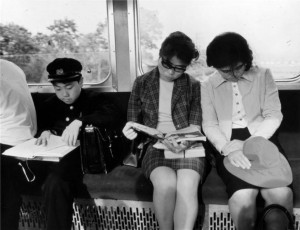 Granted, I am just talking about external impressions, not contents. But external impressions are not without their own kind of content. They bear upon cultural assumptions, and these can be profound. I would not argue that the Anna Karenina read on e-book is different from that read on the page. But the act of reading it is somewhat different, both in its mechanics and its outer signification, and that difference bears on our collective assessment of value. Keep in mind that these reading technologies are not entirely new systems of delivery–they are a transformation of an older system. Pagination is retained, margins, paragraphing. There is continuity. It’s just that the husk, which had come to mean so many things in our private and social lives, has been stripped off. Though the e-reader is physical, the book itself has been vaporized, taken out of spatial existence, made ghostly. It has changed the nature of its public representation. We knew of books because we read them; we knew of them, too, because we saw them–on shelves, on tables, in piles by peoples’ bedsides. And this seeing told us a great deal about the situation of the book, its place in our book-culture. It made it real, much as the sight of planted fields makes real the produce that I buy in the supermarket.
Granted, I am just talking about external impressions, not contents. But external impressions are not without their own kind of content. They bear upon cultural assumptions, and these can be profound. I would not argue that the Anna Karenina read on e-book is different from that read on the page. But the act of reading it is somewhat different, both in its mechanics and its outer signification, and that difference bears on our collective assessment of value. Keep in mind that these reading technologies are not entirely new systems of delivery–they are a transformation of an older system. Pagination is retained, margins, paragraphing. There is continuity. It’s just that the husk, which had come to mean so many things in our private and social lives, has been stripped off. Though the e-reader is physical, the book itself has been vaporized, taken out of spatial existence, made ghostly. It has changed the nature of its public representation. We knew of books because we read them; we knew of them, too, because we saw them–on shelves, on tables, in piles by peoples’ bedsides. And this seeing told us a great deal about the situation of the book, its place in our book-culture. It made it real, much as the sight of planted fields makes real the produce that I buy in the supermarket.
I come back to the image at the beginning of Kertesz’s book–the one of the open book. It would, I realize, have no place in the supplement volume, On Reading 2.0. Try to conjure up that same window and desk and position on that desk a sleek Kindle Reader. Does it extend anything like the invitation that the open book extends? Does it offer any more suggestive promise than the sight of a blank television screen. One might say that both exalt with pure potentiality, but in my experience, the TV has come to stand for nothing at all. It does not, for me, equate to its finest or its least interesting contents, any more than my microwave oven makes me think of any of the delicacies it has warmed up. It is purely neutral, a means to an end. Period.
But no, that’s not the end of it–revoke that period. Now and for a long time to come the Kindle, or any other reading machine, stands not only for itself, but also for the object, the technology, it is displacing. And an album, like Kertesz’s, only dedicated to images of people using this standardized device, becomes a kind of elegy, a token of uniformity, of familiar objects dematerialized. We see the reverse image, the negative, of everything that Kertesz was celebrating.
But this is not the way to end. Better, I think, to turn the lens back to reading, the process and not the enabling means. So long as reading survives, it certifies us as a symbol-making species, pledged to live in the material realm but also at one remove from it. This is both a curse and a freedom. A curse, because as the poet Rilke observed in his Duino Elegies “…already the knowing animals are aware/ that we are not really at home in our interpreted world.” We suffer the anxieties of consciousness, more piercingly as the world grows more complex, but there is nothing to be done. The apple cannot be uneaten. What we have as our resource is the same symbol-making ability that originally opened the world to interpretation. It takes many forms, but writing and reading are possibly the most potent, at least the most concentrated. The imperative of both is so strong that the means become secondary, if not moot. I do have a very deep allegiance to the particular technology that is the printed book, and I have argued its merits at length. But at the same time I can see, as if in a time-lapse visual sequence, the historical movement, what sometimes feels like the accelerated film of a metamorphosis that we used to watch in science class. Papyrus, vellum, the scratching of nibs in scriptoria, the first codices, the thousand and one iterations of the basic book premise, the Kindle–and I can coach myself to see these as the outer garb of something struggling for release, not there yet. Something–but what? There are no answers forthcoming, not from me, but looking through the archive of Kertesz’s photographs I do get a sense of its potency and the complex and emotionally rich forms it has taken and will continue to take.
Posted: May 9, 2012 at 10:22 pm


